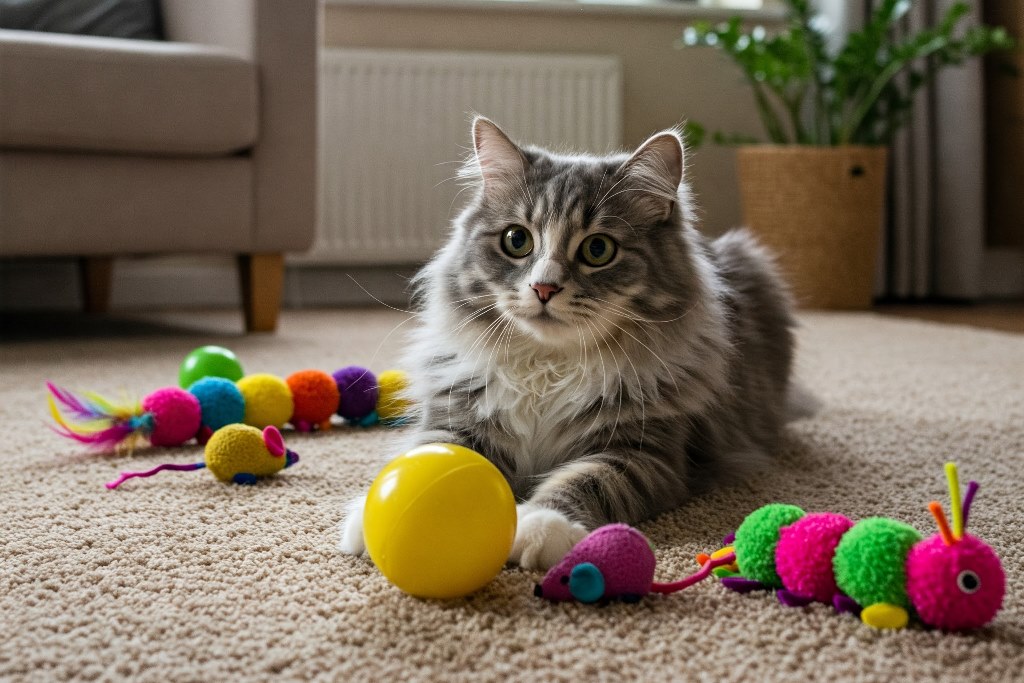
Sensory Education for Cats: Enhancing Their Senses
When it comes to enhancing the quality of life for cats, one of the most effective, yet often overlooked, approaches is sensory education. Just like humans, cats experience and interact with their environment through their senses — sight, hearing, and smell. As highly intuitive and curious creatures, cats rely heavily on their sensory perception to navigate the world around them, understand their surroundings, and communicate with their owners. By stimulating and improving these senses through purposeful training, you can enhance your cat’s cognitive functions, emotional well-being, and overall interaction with their environment.
In this article, we will explore the concept of sensory education for cats, discuss its importance, and provide a detailed, step-by-step guide to creating an educational program that focuses on the three primary senses: sight, hearing, and smell.
The Importance of Sensory Education for Cats
Cats are born with an extraordinary set of senses. Their vision allows them to see in low light, their sense of hearing is incredibly sharp, and their sense of smell is far superior to ours. By engaging and stimulating these senses through education, you not only foster a deeper bond with your pet, but you also:
Enhance Cognitive Development: Mental stimulation is just as important as physical exercise. Sensory games and activities promote learning, problem-solving, and memory retention.
Boost Emotional Health: Cats can experience stress, boredom, and anxiety. Sensory education provides an outlet for mental engagement, reducing stress and encouraging natural behaviors.
Encourage Socialization: A cat that is mentally and sensory-engaged is more likely to interact positively with both humans and other animals.
Prevent Behavioral Issues: Lack of sensory stimulation can lead to unwanted behaviors such as scratching, biting, or excessive meowing. Stimulating their senses helps prevent such behaviors by keeping their minds active and focused.
Sensory Education: A Focus on Sight, Hearing, and Smell
1. Sight: Enhancing Visual Stimulation
Cats are highly visual creatures, and their sight is adapted to detect movement, rather than focus on fine detail. They see in shades of blue and green and are incredibly adept at detecting motion, especially in dim lighting. To engage your cat’s sight, here are a few activities you can introduce:
A. Visual Tracking Games
Create a fun game by moving a toy or laser pointer in front of your cat. Move the object slowly at first, allowing your cat to follow its movement. Gradually increase the speed and change directions to encourage your cat to track it with their eyes. This exercise helps to improve their ability to focus on moving objects and sharpens their visual acuity.
B. Interactive Toys and Puzzles
Puzzle feeders and toys that require your cat to engage with them visually can stimulate their problem-solving abilities. Toys that use varying colors and patterns can encourage curiosity, while the movement of toys like balls and feather wands can improve your cat's tracking skills.
C. Creating a Window Perch
Cats love to observe the world around them. Setting up a safe perch or window bed gives your cat a spot to watch birds, cars, and other animals, providing endless visual stimulation. This not only engages their sense of sight but also satisfies their natural curiosity.
D. Contrast and Color Exposure
Introduce toys and objects with contrasting colors. Brightly colored items or toys that move with varying speeds can keep your cat's attention fixed, helping them hone their ability to differentiate between shapes, colors, and movements.
2. Hearing: Sharpening Auditory Perception
A cat’s sense of hearing is far superior to that of humans. Cats can hear a wider range of frequencies, from 48 Hz to 85 kHz, compared to the human range of 20 Hz to 20 kHz. This heightened sensitivity allows them to detect even the slightest sounds, which is crucial for their survival in the wild.
A. Sound Stimulation with Clicker Training
Clicker training is a great way to engage your cat’s auditory senses. The sound of the clicker can be used as a signal for good behavior, reinforcing positive actions. Start by associating the clicker sound with a reward (treat or praise) to help your cat link the sound with positive reinforcement. Over time, your cat will associate the sound with a specific behavior or command.
B. Music and Auditory Stimuli
Some cats are highly responsive to music, while others may prefer the sound of nature. You can experiment with various types of music, such as classical or calming soundscapes. There are even specially designed playlists that target cats' hearing frequencies. This can help soothe anxious cats or stimulate their curiosity.
C. Auditory Enrichment Through Play
Toys that make noise—like crinkle balls, bells, or squeakers—engage your cat’s hearing and encourage interaction. Additionally, using sounds like a chirping bird or rustling leaves (available through various sound apps or toys) can prompt your cat to “hunt” or play, sharpening their response to sounds in their environment.
D. Environmental Sounds and Sound Associations
Introduce your cat to different household sounds, such as the sound of a doorbell, a vacuum cleaner, or a running faucet. Help your cat build positive associations with these noises by pairing them with treats or petting, which can reduce anxiety around unfamiliar sounds.
3. Smell: Stimulating the Olfactory Senses
The sense of smell is the most developed of all a cat’s senses. Cats rely on their noses not only to detect food but also to communicate with other cats through scent marking. Sensory education that incorporates olfactory stimulation is essential for providing a holistic enrichment program.
A. Scented Toys and Treats
Introduce your cat to a variety of scents using specially designed scented toys or treats. You can use different herbs, like catnip or valerian, to see how your cat responds. These natural aromas can help reduce stress and increase engagement with toys. For example, catnip stimulates playfulness, while valerian has a calming effect on some cats.
B. Scent Trails and Hide-and-Seek Games
Create scent trails using treats or a small amount of their favorite food. Place the treat at the end of the trail and encourage your cat to find it. This taps into their natural hunting instincts and gives them a fun challenge to follow the scent, stimulating both their sense of smell and mental agility.
C. Introducing New Scents
Change up your cat's environment by introducing new scents. For instance, you can place a few drops of essential oils (safe for cats, like lavender) on a cotton ball, or you can even let your cat explore various food or herb scents. This helps keep their sense of smell sharp and provides them with a new olfactory experience.
D. Scented Objects for Familiarization
Place objects that smell like different environments in their space, such as a piece of clothing or a blanket from a different room. This helps your cat build positive associations with different scents, which can be useful when transitioning them to new environments, like a veterinary clinic or a trip.
Step-by-Step Guide to Creating a Sensory Education Program for Your Cat
Assess Your Cat’s Current Sensory Stimulation Needs: Begin by observing your cat's behavior and identifying any sensory deficiencies. Are they overly anxious, disinterested, or overstimulated? Understanding their baseline will help guide your approach.
Select Sensory Enrichment Activities: Choose activities that engage the three primary senses (sight, hearing, and smell). Make sure to introduce new elements gradually, and don't overwhelm your cat with too many changes at once.
Create a Schedule: Incorporate sensory activities into your cat’s daily routine. Aim for at least 10-15 minutes of sensory engagement each day. Break this into shorter sessions if your cat becomes overstimulated.
Monitor Reactions and Adapt: Keep an eye on how your cat responds to the activities. If a certain activity causes stress or disinterest, try to modify it or introduce something new. Adjust the frequency or intensity of sensory activities based on your cat's comfort level.
Incorporate Play and Rewards: Sensory education should feel like play, not a chore. Use positive reinforcement (treats, praise, or petting) to reward your cat for engaging with activities, ensuring that the experience remains enjoyable.
Sensory education is a powerful tool to enhance your cat’s mental stimulation, emotional health, and interaction with their surroundings. By focusing on engaging their sight, hearing, and smell, you can create a comprehensive enrichment program that not only nurtures their natural instincts but also strengthens the bond you share. A well-stimulated cat is a happy and healthy cat, so start incorporating sensory activities into your cat’s daily routine and watch their curiosity and joy grow!
If you need more tips or specific sensory training ideas for your cat, don’t hesitate to reach out to your vet or animal behaviorist for personalized guidance.






















